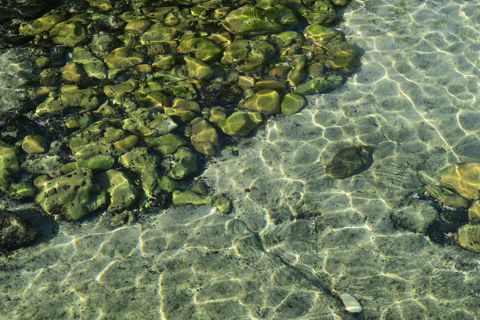| itinerary < 26 July to SFO Puako Day Two too busy to describe > | Puako 27 July 2021 |
Recovery DayWe have found that adults do not travel well. However, waking up in a spectacular new place gives recovery a hearty good start! Sparkly blue morning; coffee and tea barely drunk, and we're off down the Beach Access across the street to see if there really is an ocean. We are not precisely from Missouri, but we did arrive in the night, and there was no evidence of water. |
 Some of the intertidal zone looks like this |
 |
This may be Stella's nominee for the most interest animal of the day – a Gecko found on the fence beside the Access. She and it regarded each other at length and depth. She is very interested and well informed about natural phenomena, and hungry for more. Her brother Devan is equally inquisitive about the bits that interest him; currently, the local volcano fascinates. Next week. |
|
Craig noticed what the rest of us walked right by: a Green Turtle sunning herself (I'm sure it was a she), recharging hee thermal batteries before going back to sea. Keeping a respectful distance we noticed that for awhile, only her head moved slightly, and she blinked. “Is she sick? Should we throw water on her?” “Nope, she's doing fine.” |
 |
 |
My nominee for most interesting water animal of the day: a black Sea Slug spangled with little white stars. [ Alert: bummer ahead! ] Chad declines to put on a mask and snorkel, claiming that his adventuring days are over; he's too old. But then he gets serious and says he remembers vividly what it looked like before, a wonderland, and he chooses not to spoil that memory.
|
|
Too sad, but it's true. Whether for natural reasons of the usual litany of climate change, agricultural runoff, poisonous tourist sunblock (the word “poisonous is meant to modify ”sunblock,“ not ”tourist“), resort septage and reduction of precipitation runoff, what used to be a fin reef populated by innumerable fish species, is a desert of broken coral. A few hard corals still survive, but unaccompanied by the expected clouds of little blue fish. I remember the days when it was a very rare morning that I snorkeled out and didn't see a new fish ...but the memory fades into a sad and distant past.
On the brighter side, the Green Turtle recovery in these waters is remarkable, as is the respect with which they're treated by the humans. Noble creatures! So, as you see, our turtle turned around and propelled herself slowly down the beach, entered the surf, and with uncanny grasp of the effects of the little waves, launched herself out to sea. |
 |
 |
 |
Even in a desert, there are evidences of life. The top of a sea urchin cast; a discarded crab carapace, one of those “Martian” urchins that abound here on the Big Island, with a purple underside, stubby spines, and a hexagonal mosaic Bucky back! (Here we have the underside. |
 |
|
 Sienna: Panorama of our beach, the bay, North Kohala Mountains |
 |
updated 16 June 2023 Caspar Time site software and photographs by the Caspar Institute except as noted this site generated with 100% recycled electrons! send website feedback to the CI webster © copyright 2002-2024 Caspar Institute |